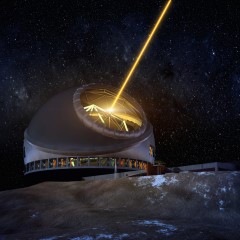Thirty Meter Telescope: The 30-meter class telescope to be built in Hawaii will use adaptive optics to provide diffraction-limited imaging and unprecedented light-gathering power. The capabilities of the Thirty Meter Telescope will complement those of the James Webb Space Telescope in tracing the evolution of galaxies and the formation of stars and planets.
Credit: Courtesy TMT Observatory Corporation
The point I would make about the UV science is that there’s a lot to be done, which I think is true for all science. You just have to start digging your hole someplace, and pretty soon you’re going to find gold. It’s very exciting to be a scientist. You have to choose where you’re going to dig, but there’s a lot of opportunity.
I want to talk about where astronomy is going and here I am referring to all of astronomy, not just UV astronomy. We stand on the edge of constructing some of the most exciting facilities the world has ever seen. I taught a course in space science and space technology to sophomores, juniors and seniors this year, and I asked Dr. John Mather, the project scientist for the James Webb Space Telescope to talk to the class about the telescope. At the end, I told the class, “You know, this telescope is probably going to fly in 2018 or maybe a little later. You’re young enough that maybe you will work in the preparation of that telescope. Some of you may even use that telescope.”
I think we’re going to have fantastic facilities. On the ground, we’re talking about building telescopes for the visible and near infrared that are thirty meters across. That’s almost a hundred feet. That’s a lot. An acre lot is about 200 feet on each side, so this is something that would cover 25% of an acre. High in the Atacama desert in Chile at an altitude of 16,500 feet, the United States, Europe, and Japan have built a radio telescope array with 65 antennas, some as large as 40 feet in diameter. It has an angular resolution that’s as good as or better than the Hubble Space Telescope, and a spectral resolution that is much higher than that of the Hubble. There are so many things going on in astronomy; it is a very exciting field.



